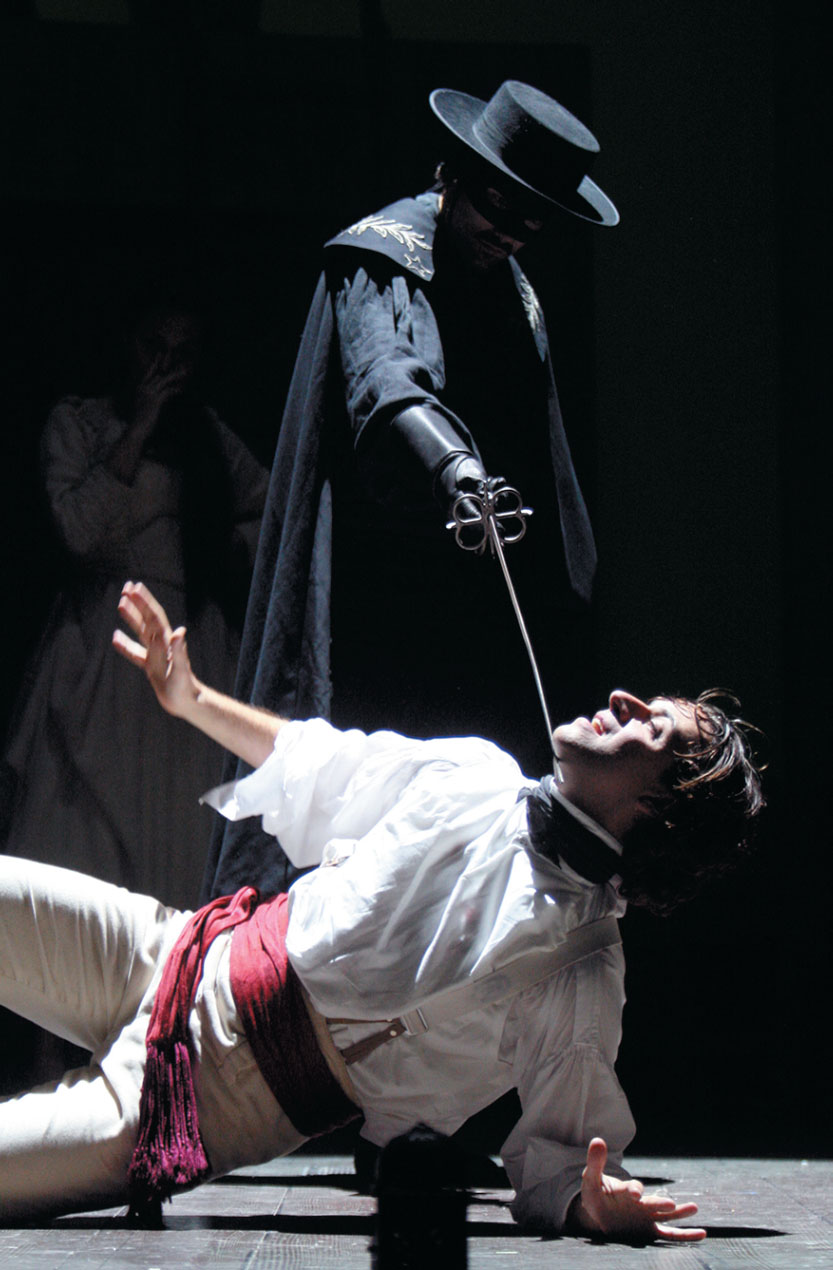
[caption id="GiovannisHadrianandZorrotheMusical_img1" align="aligncenter" width="241"]

ALISTAIR MUIR
He’s swashed and buckled, swung and slashed his way through every child’s fantasies, torched every villain’s evil plans and thrust his way into every swooning female’s heart. But given the number of times Zorro’s made it to the screen, both big and small, it seems a tall order to see him on a London stage without him seeming—well—a bit puny, really.
I went into the new West End musical version of Zorro with some slight apprehension. The Garrick is a cute little gilded, becherubbed, historic theater—and this production uses the heady, steamy, sexy Latino music of The Gipsy Kings. Surely the wild, untamed Zorro couldn’t be hemmed into such a place? Well, no—ultimately he can’t. By the end of this fabulous spectacle, the constraints of a mere proscenium arch are too much and the masked marauder’s ecstatic swing from the gods to the stage is a release both cathartic and wholly expected.
ZORRO
‘Ravishing gypsies, incredible flamenco dancing’
What I love about this production, told from the point of view of a wandering flamenco troupe, is that it never actually takes itself seriously. There’s no doubting the spectacle element—the giant flaming “Z” alone must have given the fire officers a few headaches—but this is panto, pure and simple. And it’s great fun. Matt Rawle, as Diego, camps it up from beginning to end, but he laughs at himself, not the show. Gorgeous, sensual Inez, played by Lesli Margherita, flounces and flashes her eyes; Adam Levy’s evil Ramon struts around sneering—they are clearly enjoying themselves hugely. There’s nothing unpredictable in the whole plot—but that’s just how this kind of show should be. Ravishing gypsies, incredible flamenco dancing, comedy sidekicks and a couple of big-hitter singalong songs. Even with the plethora of musicals on at the West End just now, this one’s a keeper.
Irather wished I’d had Zorro’s head for heights when testing out the Greenwich Observation Wheel. While the Cutty Sark is being restored (we have just discovered that she has the funds for a complete restoration, thanks to a £3 million donation from billionaire businessman Sammy Ofer) the Greenwich Foundation brought a miniature version of the London Eye downstream for the summer. It’s much smaller than the London Eye, but just as enjoyable in its own way, with staggering views of the Royal Naval College and the Old Royal Observatory. It only lasted to the autumn, but I have high hopes it will be back next year. In the meanwhile, the real thing, on the South Bank, is still one of the best things to do in London and warrants two visits—one by sunny day, the other as the twilight fades.
Greenwich Observation Wheel
‘With staggering views of the Royal Naval College’
The British Museum’s big exhibition last year was the astounding First Emperor blockbuster, where a couple of dozen warriors from China’s Terracotta Army were brought over with other, perhaps even more extraordinary items to create a production piece that went beyond mere objects in glass cases and into theater. I was curious indeed to see how they would follow something like that. But in its own way, the new Hadrian: Empire and Conflict exhibition is just as spectacular.
It’s in the space created for the First Emperor, on a mezzanine above the historic Reading Room, but it has a much airier, simpler feel to it than the labyrinthine Terracotta Warrior exhibit.
One of the biggest challenges has been that it’s difficult to get close to Hadrian the man. There’s plenty about him as an emperor, a warrior—even a god—but precious little survives about how he actually lived. Nevertheless, the curators have made an excellent fist in the attempt. The model of his palace at Tivoli is so fantastic that I have decided Rome’s my next holiday, and the thoughtful section about his grief at the death of his lover Antinous, which led to the young man being deified, is both dignified and moving. Much is made of the number of statues in the exhibition—the best collection of the emperor’s images put together, and, since this is not a touring show, possibly that will be put together for the foreseeable future. I am impressed, too, at the generosity of the Turkish government, which discovered a colossus of Hadrian last year on what has to be one of the world’s most exciting current digs and has lent it to the British Museum before even showing it to its own people.
Hadrian—Empire and Conflict
‘The new exhibition is just as spectacular’
I have lived in London all my life. I have been visiting the West End since I was a child—and yet it still manages to throw me a curve every so often. I was walking along St. Martin’s Lane with a pal one night a couple of months back, when the man just ahead of me disappeared. I would have put it down to the bottle of wine we’d just shared, if we hadn’t at that moment spotted something. A tiny alleyway, not much wider than the man who had just disappeared, cut into a wall. “To Giovanni’s Restaurant,” announced a faded, ancient sign. We stepped into the darkened corridor and found ourselves in another world.
[caption id="GiovannisHadrianandZorrotheMusical_img2" align="aligncenter" width="1024"]

ALISTAIR MUIR
[caption id="GiovannisHadrianandZorrotheMusical_img3" align="aligncenter" width="833"]

ALISTAIR MUIR
Goodwin’s Court is the closest I have ever come to stepping inside Harry Potter’s Diagon Alley. Built around 1627 as Fisher’s Alley, its row of bow-fronted Georgian shops (now rather posh offices) boasts gleaming doorknockers on black, gloss-painted doors, dating back to 1690, and working gas lamps, all in a street so tiny you’d be pressed to get a bicycle down it. It’s a cut-through coming out at Bedfordbury, and even if you know where this place is, you still can’t find it until you’re right on top of it.
But what of the mysterious Giovanni’s? The sign, peeling with age, could have been from another world, too. But right at the end, there it was. A closed door that most definitely said “Giovanni’s.” Next to it a little bow-front window with an awning in the Italian colors. Was it a private club? I vowed to return.
THIS MONTH’S CONTACTS
ZORRO — Garrick Theatre, Charing Cross Road.
www.zorrothemusical.com
GREENWICH OBSERVATION WHEEL — Sandra has high hopes it will be back next summer.
HADRIAN—EMPIRE AND CONFLICT — British Museum. www.britishmuseum.org
GIOVANNI’S — 10 Goodwin’s Court, WC2.
Giovanni’s is an odd restaurant. With its friendly waiters-of-a-certain-age, making well-rehearsed quips and playing antediluvian practical jokes; with its fading photographs of famous opera stars who always come to Giovanni’s whenever they’re in town and with its no-nonsense repertoire of Italian classics, it has a cosiness that makes up for its crusty 1970s feel.
Giovanni’s
‘It has a cosiness that makes up for its crusty 1970s feel’
Definitely Giovanni’s is a place for the atmosphere, but the food is rather hit-and-miss—I had a great plate of pasta, but my partner’s lamb had perhaps seen better days. The bread was stale and the oil tasted decidedly old, but the seafood salad was very enjoyable. The room itself has an ornate plaster ceiling and exposed beams whose authenticity is impossible to deduce (it is in Good-win Court, but…) and opens out onto the much more touristy New Row, giving it a slightly schizophrenic feel—is it an undiscovered gem or a tourist trap? Even after a couple of visits, I’m still not sure.
Next issue I’ll be going French in Soho, delving into the mysterious world of Freemasonry and trying to get my money’s worth from a Historic Royal Palaces season ticket.





Comments